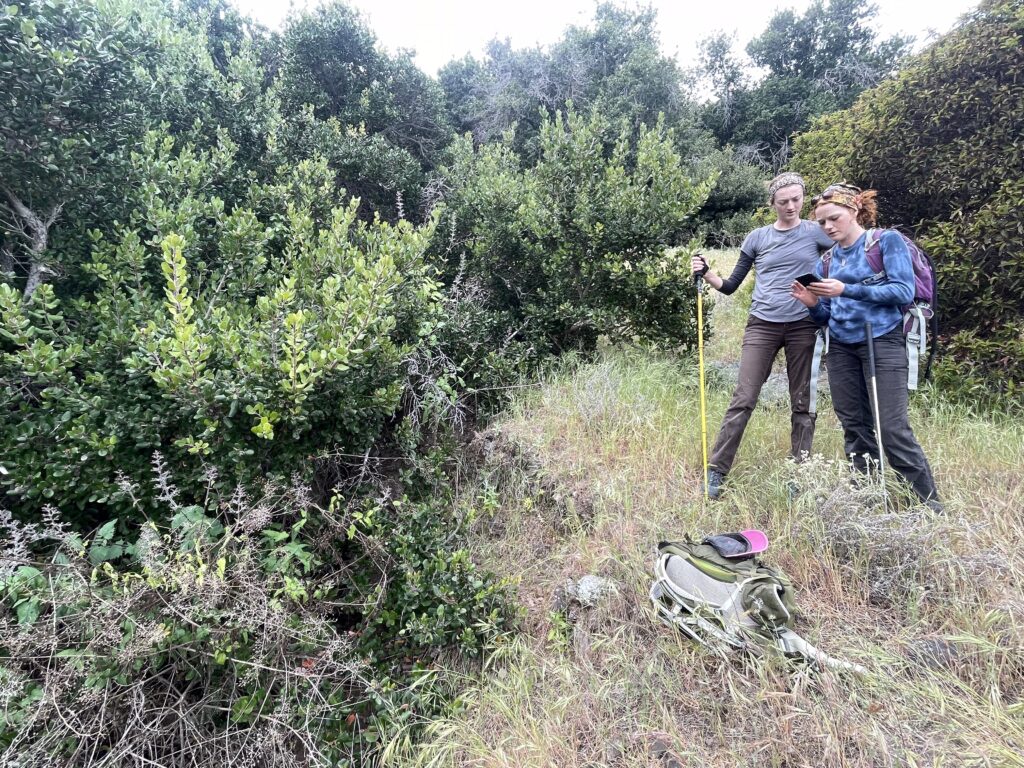
A quarter century after wildfire ravaged the windward side of Catalina Island, a small team of Catalina Island Conservancy botanists ventured by boat to Goat Harbor to assess the vegetation. Their survey revealed not only widespread non-native grasses and invasive plants, but the surprising discovery of a rare, protected plant that was previously unaccounted for in this part of the Island.
“We chartered a local fishing boat, the ‘Mojo,’ and got dropped off on a remote part of the Island with no road access,” said Native Plants Manager Kevin Alison, recounting the epic excursion that began at Cabrillo Beach. “We rowed ashore in shark infested waters – there were leopard sharks everywhere – to monitor the plants for four days.”

Camping in a remote site, Alison and his team of five researchers spent their days tracking plant growth with the point-line-intercept method. It’s the same approach that was used the last time this landscape was surveyed in 1999 and involves establishing points, known as transects, along a 100-foot line between two poles. Everything touching the pole is identified, measured and recorded. This method prevents bias by the researcher.
“It’s a very standardized method of understanding plant coverage and biodiversity within a given space so that you can then make inferences at larger scale,” Alison explained, noting that the work includes snapping photos of the same area for visual comparison. “You’re literally time traveling and seeing the vegetation over a quarter century.”
One of their observations was that a majority of the transects show a dominance of non-native annual grasses. Shrubs with higher deer-resistant traits such as bitterness and sticky resin – like Southern monkey flower (Diplacus puniceus), prickly pear cactus (Opuntia littoralis), lemonade berry (Rhus integrifolia) and laurel sumac (Malosma laurina) – persisted and proliferated. They also noted that the laurel sumac, which burned in the 1999 fire, has successfully recovered and expanded across the landscape.

Alison and his team also discovered a growth of Southern honeysuckle (Lonicera subspicata var. subspicata), a rare plant with a protected designation in California. It’s rare both on the mainland and the Channel Islands. Prior to this recording, only two other populations had been confirmed across the islands: one on White’s Landing on Catalina Island and another on Santa Cruz Island.
“When we went to Cabrillo, we found it right there on the beach,” said Alison. “That helps us understand the ecology of it – it must need the beach environment. When things make it to islands, they radiate and can become a whole new species. So, this finding warrants us talking with other scientists and geneticists to see if it could be a Catalina Island endemic variation.”
This survey also marked the first time the Catalina figwort (Scrophularia villosa), a Southern Channel Island endemic plant, has been discovered in the Cabrillo Harbor watershed. It is rare, also holding a protected species designation. However, Alison explained that finding the young and exposed figwort under the dripline of the cherry tree makes browsing by deer a concern.
Nearly every island cherry tree showed signs of heavy browsing pressure with a clear line of foraging where vegetation was within reach of deer. The removal of vegetation drastically exposed a deep, open understory, which provides habitat for shadier non-native annual grasses like ripgut brome (Bromus diandrus) and large patches of stinging nettle (Urtica dioica).

The crew removed all non-native invasive sea rocket (Cakile maritima) and wild radish (Raphanus sativus) from Cabrillo Beach, intercepting the plants before they were in complete flower and capable of producing viable seed. Fortunately, no flax-leaf broom (Genista linifolia) or French broom (Genista monspessulana) were found in the surveyed portions of Cabrillo Harbor Watershed, thought a sizable amount of fennel (Foeniculum vulgare) was observed along the beach and coastal bluff areas.
This plant survey was one of five of 30 completed this year, with 60 transects over the last two years to include the identification and recording of 15-18,000 plants.
“It’s a lot of work. It’s not easy hiking all over the Island and accessing remote areas,” shared Alison. “But we now have an intimate understanding of what the vegetation on the Island is and has been and could be.”



